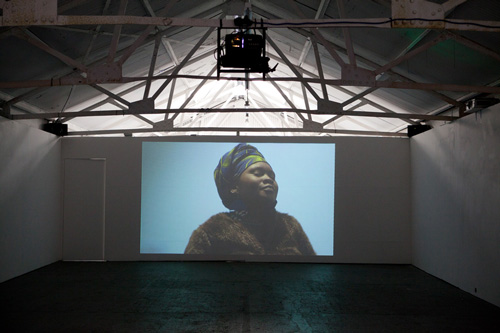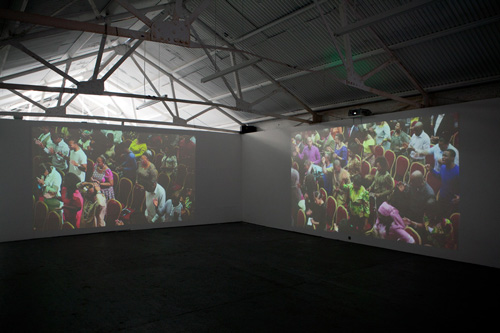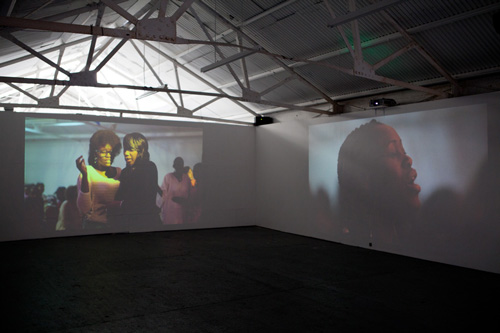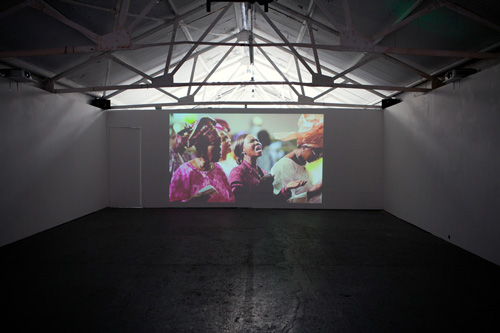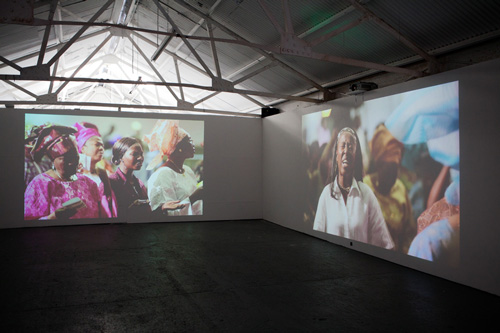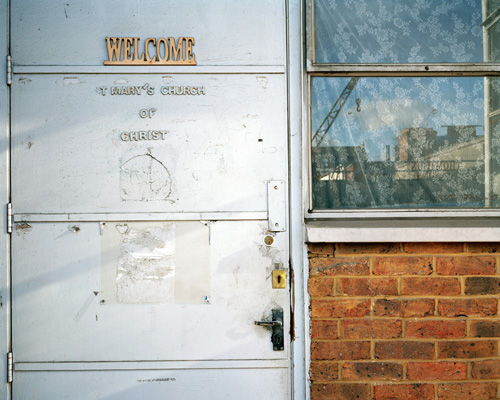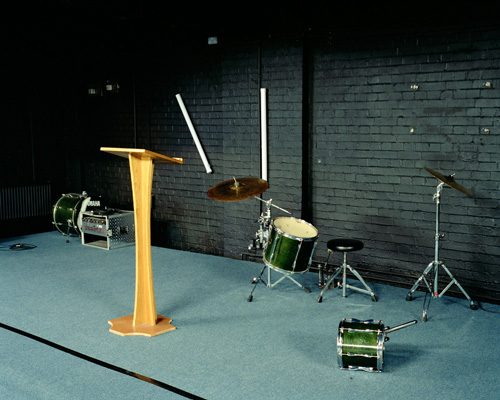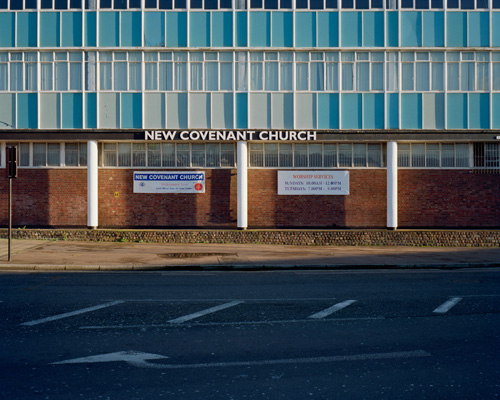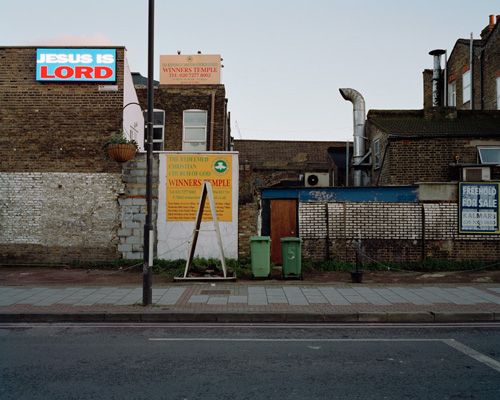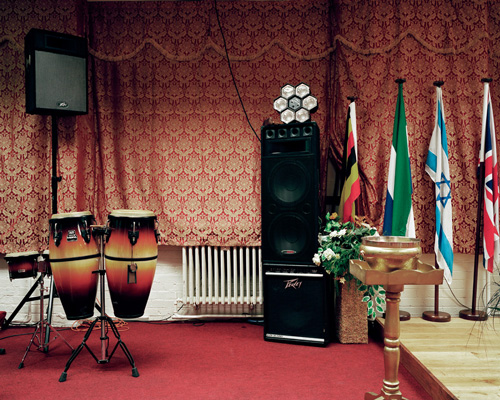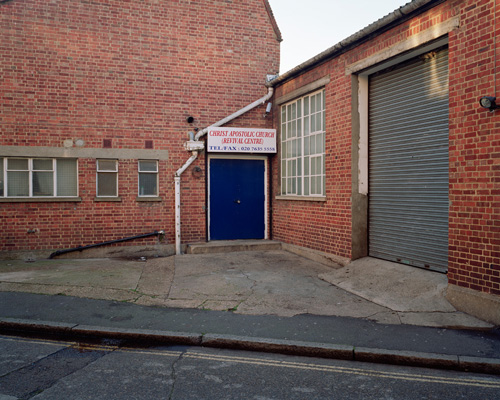

by HARRIET THORPE
As I walk through the Copeland Park industrial estate from Peckham High Street in the south-east London borough of Southwark on a Sunday, I see people spilling out of discreet doorways between yoga studios, cafes and unmarked buildings. A pulse of music heightens and falls with the swing of the door, as a man steps out on to the pathway rocking a baby.
In a one-storey warehouse space across a car park, there is a door marked Bosse & Baum. Inside the new gallery there, Congregation, an installation by Chloe Dewe Mathews (b1982), is projected on to three walls. Standing in the middle of the space, one, then two, then three videos appear. Sound builds and accumulates and soon you find yourself at the centre of the congregation, in a maelstrom of movement, patterns and colours, where people are captured in the midst of worship.
A series of C-type print photographs shows Dewe Mathews’s documentation of the outside doorways of African churches in Southwark. The signs are bold yet unassuming and they occupy unconventional spaces, blending in with the fabric of the city.
Harriet Thorpe: How did you become interested in Southwark’s African churches?
Chloe Dewe Mathews: I’ve lived in the area for the past few years. I went to [the nearby] Camberwell College of Arts about 15 years ago, so my friends have lived around here and I’ve always been aware of the churches: the extraordinary signs on the grey London street, or in industrial estates, with these wonderfully epic names, such as “Holy Ghost Zone”, “Freedom Centre International” and “Mountain of Fire and Miracles Ministry” – some of the names are very emotive; and being there on a Sunday, you see this amazing shift in the visual landscape with all the church-goers dressed up exquisitely, waiting at the bus stop or walking to or from a service.
I noticed the audio shift as well, even just wandering down the street; you hear the sounds of different services reverberating out of non-descript buildings, sometimes from many directions at once. That was always intriguing to me, and something I had considered making work about. The catalyst came when Tate Modern commissioned me to do a piece about Southwark. It commissions a piece of work about the local area of Southwark every year. I started doing some research and found that Roehampton University had done a big study on black majority churches in London. It found that Southwark had the highest density of African churches anywhere in the world outside Africa. Reading that, I thought, I’ve got to make work about this. Then I started visiting the churches and making relationships with the pastors and photographing.
HT: How did you begin those relationships?
CDM: I was introduced to a few of the churches through a network called Southwark for Jesus, so I contacted them and explained what I was doing. With others, I just walked in off the street. I was amazingly lucky that I always had such a positive response. Each time I would go to the pastor and explain what we were doing and then they would tell me which services I could come along to and how I should introduce myself.
I had a strong relationship with three of the churches and then looser relationships with other ones. With those three churches, I would go to meetings and sometimes do announcements during the services, explaining what I was there for. I put posters around to say that I was videoing, asking anyone who didn’t want to be filmed to let me know. It was about people knowing what I was up to and then sticking around at the end of the service if people wanted to ask more.
Although there are moments of great intensity during a service, it’s also quite an informal atmosphere where having cameras around felt normal. I felt very welcome. I think also because these are Evangelical churches, they are looking outwards and are open to curious people, so the idea of having a photographer making work about what they do is not a bad thing.
One of the pastors was really interested in art and thought that it was a wonderful way of talking about what they were doing. We just did a panel discussion where he joined the professor from the University of Roehampton and a Southwark councillor involved in urban development, to discuss the work.
The pastor was talking about the merits of the video installation and saying that the arresting visuals were a celebration of what happens in church and doing something visually stimulating for him is a way of engaging with God’s work.
HT: How did you work with the lights and music that are so atmospheric in the work?
CDM: I was trying to achieve some sort of amalgamation, a drawing together of the various churches in the area, into one piece of work. It’s a way of gesturing towards the multi-layered, sensory experience of going to one of these services. As you can see, there are not many shots of pastors or the actual service. It’s really about the congregation and how each person goes into a specific environment every Sunday, how they go on their own personal journey, but equally what happens when they get together with a huge group of people, that energy, and how that changes the individual experience. So it became less about religion and more about social behaviour.
I worked with one church that used a complex array of audiovisual technology, with roving disco lights and dry ice. In the same way that many of the churches have adapted an industrial space into a religious space, a lot of the young people have taken the lead on how they want the service to be: they’ve given it this much more dramatic, almost club-like atmosphere. The pastor of that church was saying how, at first, it was just for one Easter service. The church said OK, we can rent these lights and we’ll do it once, and then the young people managed to persuade them to do it one more time, and they realised they enjoyed it and they were missing it when it wasn't there. They invested in the whole setup and embraced it. I suppose it helps to focus your mind. It’s interesting how these options are much more open in a less conventional church space because all of those things can change organically, according to what the people within those buildings want.
HT: How important was it to show the piece at Bosse & Baum, within the context of what the piece looks at?
CDM: Very important. We had an exhibition last May at Tate Modern and that was a way of showing what I had been photographing about six months into the work. I had created a series of photographs and started shooting video, too. I ended up showing the video piece on,a single screen, as a trailer, like a taster of what was to come, but I always wanted to develop it into a multichannel installation. I kept shooting video after the Tate show had finished and then started looking for locations to show the new work. I went back to the Copeland Park industrial estate and I came across a warehouse that had been a church that I had photographed one year before, only to find that it had become an art gallery! The building had undergone a series of changes that perfectly articulated what was going on in the area.
It’s a very beautiful space. It has an open, raw, industrial skeleton that you can see in the ceiling and a lovely natural light coming through the skylight, which has a kind of celestial beauty. I wanted to project directly on to the building. It was important to reference what had taken place in that building, to use the history of the space. I could finally complete the piece once I knew which venue it was going to be seen in: it became a three-channel video installation.
HT: You have worked a lot with photography. What made you use video for this project?
CDM: I worked in the film industry for years before I became a photographer. Then I decided I wanted to focus on the still image and I was happy with that. When people asked me if I thought I would develop into video I said, no, because working with the still image and taking photographs felt very satisfying and stimulating. However, when shooting inside the churches, I felt it the still images weren’t doing what I wanted them to do: the photographs were falling short. I couldn’t convey the dynamic, multilayered experience that developed and changed over time, so it became a necessity to shoot on video. When I started working with moving images, it felt very natural. Then I just listened my instincts when editing to try to achieve the right balance with the footage.
HT: Why was it important to you to have the multichannel installation?
CDM: I was trying to create a much more physical experience. The form of worship is exuberant, physical and performative, unlike the church I was taken to when I was growing up and at a Catholic school. Those traditional churches focus on the mental experience, whereas the new African majority churches encourage a physically connected experience. I also wanted to reference the lights and projected images in those churches, bringing the viewer in, and as they walk through the space, they become part of the congregation too.
HT: Can you tell me about the layers of sound used in the video.
CDM: I asked Coby Sey, a sound artist and musician, to create a track with the sound recordings I’d made in various churches. Although we wanted to use ambient sound, it wasn’t meant to be specifically one church or one service on a particular day, so he mixed them together to create this collaged version of a Sunday in Camberwell and Peckham. Like me, he isn’t religious, but he grew up being taken by his nan to an African majority church in Marylebone, so his experience as a young person also informed the way he was making the work. We went back and forth on the tracks and finally achieved the balance we wanted.
HT: Do you think showing the work at Bosse & Baum broadened the audience?
CDM: I think that’s definitely true. Tate Modern is a huge tourist attraction and you get an amazing number and variety of people there that you could never hope to achieve at a smaller gallery, but it doesn’t necessarily attract many of the local population. That’s certainly the reason why I wanted to show the work within the community where I’ve been photographing.
For example, on the opening night we had the Liberty House church band performing and they brought some of their friends, and it’s more likely that people from nearby churches will just walk in here, too. A lot of churches in the industrial estate have been encouraging people to come along. I think definitely, even though Tate Modern is so close, only 20 minutes on the bus, people are busy and have responsibilities. It’s difficult to get people to go on a Thursday evening for a private view or on a Sunday when they’re going to church. It’s not necessarily on people’s daily circuit. One of the pastors I worked with wants to hold a service in the gallery and he wants his whole congregation to come along. It’s always a question how you get people to come along to a show, but so far this is working really nicely.
HT: There is a majority of women in the work. Was this a coincidence or a focus for you?
CDM: I think you’re talking about the shot were you see lots of beautifully coloured headscarfs. At that church, there are three services a day, and the last one is definitely dominated by women, but the two earlier services are not, so that’s chance. That day, it was one lady’s birthday, so there were even more women present. I’d say, generally speaking, there are more women than men at the services, but only just.
HT: In the video, the focus moves from looking at individuals at eye-level to angled aerial shots of the congregation from above. Can you tell me about these two different focuses?
CDM: Because I’m trying to talk about the individual and collective experience – what happens internally and externally when you’re part of a group – that was important. A congregation is made up of individuals. On any Sunday, two people next to each other, seeing and hearing the same things, are going through a completely different experience. It becomes not so much about religion, but social experience, how people get together, how people feed off each other. It was important to show a range of experiences. You get different types of people moving in and out of concentration, to people experiencing something very intense and physical: a focused dose of the Holy Spirit.
HT: Religion has been central to a lot of negative press recently. Do you think people forget about the social benefits of religion?
CDM: It’s unfashionable to talk about religion in art nowadays. It’s a fairly secular culture, the art scene. I’m not religious, but I’m interested in what people do, and faith comes into that – it affects a huge number of people. In the art-gallery-going crowd, it’s a lesser part of people’s lives, but in the wider world, religion is one of the core elements of our culture and politics, so I think it’s important to talk about. People sometimes shy away from religion in art, but not only is religion about a certain religious text or people abiding by, or developing their understanding of those texts, but it’s also about social activity, storytelling, community, how people relate to one another and create bonds. For some people, it’s how they are able to survive in this world. For many, it’s about communication.
HT: Watching the piece, I was quite envious of the experience that people were having. It felt very cleansing and healthy.
CDM: Because it’s physical and there’s a vocal engagement – you’re singing, you’re moving, dancing, expelling all the thoughts of the week. Completely aside from the religious value, it has huge therapeutic value.
I have just been in Iran, where there are some religious ceremonies that are very visceral; singing, wailing, dancing, moving. In a culture where you’re not allowed to dance in public – well, women anyway – they have found various ways of integrating those things humans need and want into their religious practice, because they’re not allowed to do it outside of that.
The same isn’t true in London’s African churches because, obviously, here you can do most of what you want – people could go to a club on a Saturday evening and then to church on a Sunday morning, if they wanted to – but it’s quite interesting how those things are seen as a very essential part of human behaviour. If you find a way of bringing that into church, that also brings people to church. As a pastor, you’re trying to get people into church and then you can then deal with bigger issues that those people are going through. They want to create an environment that people enjoy, find stimulating and look forward to returning to.
At first it was surprising to see disco lights, projected song lyrics and dry ice in a church, but that idea of embracing technology makes sense. You go to a Catholic church around the corner and there are six people in the church. There is potentially a reason for that, which is that they are operating on a model that worked 200 years ago.
It’s partly because the buildings are warehouse spaces, which are versatile spaces that don’t already have a prescribed way of using them. They do become much more open to the people and that specific congregation who are going to that church, using it in a way they feel is right for them, which reflects the fascinating way that the city is organically shaped by the people who live in it.
HT: Is the piece you were working on in Iran about religion, too?
CDM: That’s part of a long-term piece called Caspian. It’s all about how people relate to the land, environment and the natural resources in the area, so it does involve religion and ritual in part, but not exclusively. In Iran, I was spending time with the Zoroastrian community because of the use of earth, fire and water in their practice – so it has more to do with that relationship with the environment and the space around them.
HT: Is there an underlying theme that links all your work?
CDM: Very broadly, it’s often about people’s relationship to their environment. I think each project investigates that in a different way. Some work focuses more on the history of spaces, while other work explores ritual and how we as humans invest meaning in the materials around us. It’s all storytelling in the end.
• Chloe Dewe Mathews: Congregation is at Bosse & Baum, London from 29 May – 21 June 2015.
